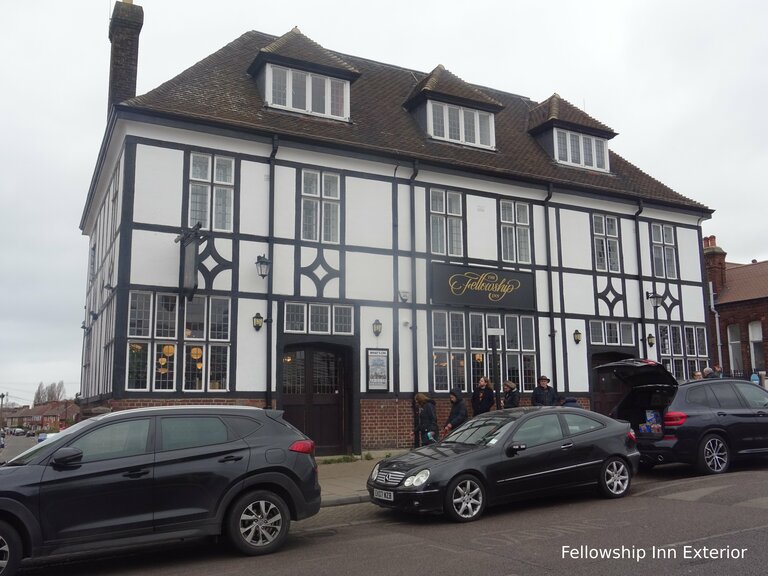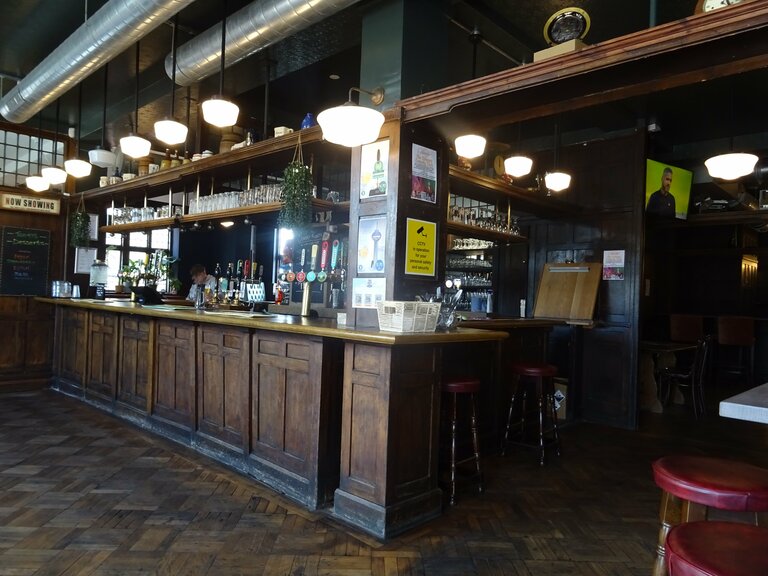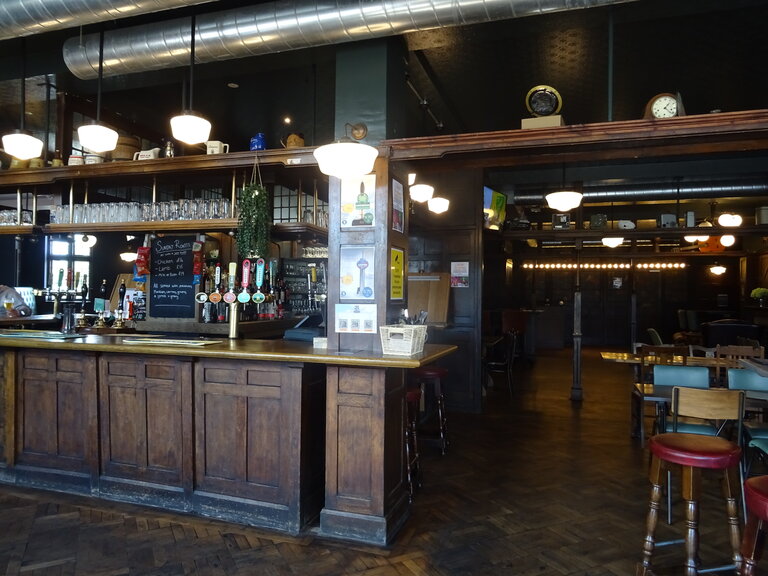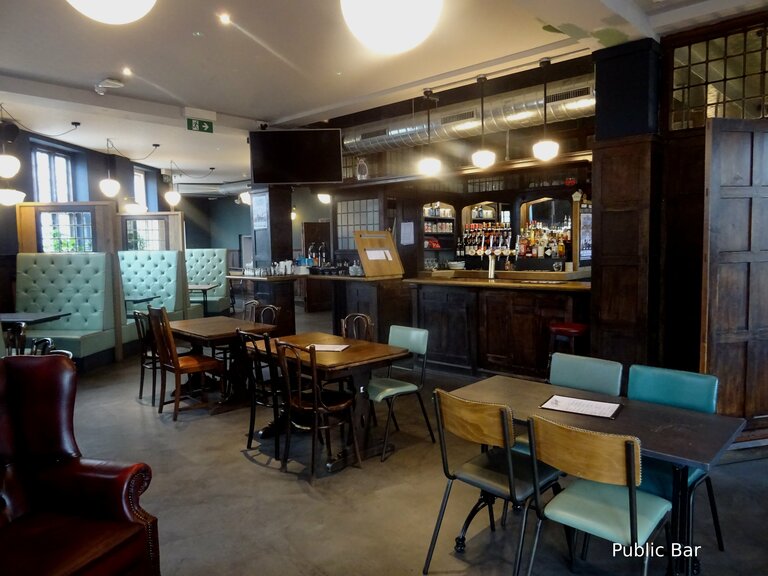Fellowship Inn
Randlesdown RdBellingham
SE6 3BT
This pub is not only a grade II listed building, it is also a Two Star pub on the Campaign for Real Ale’s (CAMRA) National Inventory with an interior of very special national historic interest, and the description is as follows: “The Fellowship Inn is an ‘improved’ public house built in 1923-4 by F.G. Newnham, the house architect of the brewery Barclay Perkins and Co. It was built as part of the London County Council’s Bellingham Estate. Built of brick with tall brick chimneys it has two storeys plus attic and a basement in a half-timbered ‘Brewers' Tudor’ style. After a wonderful restoration and sympathetic refurbishment to many parts of the building by the Phoenix Community Housing Trust in 2018/9, the pub now has the public bar re-opened in addition to the saloon bar on the ground floor. On the left-hand side is the public bar (shown on the original plan as Public Refreshment Room), which retains a large entrance lobby screen, original dado of fielded panelling with modern wallpaper above, and a stone Tudor-arched fire surround, brick interior and wood surround fireplace. The bar counter is original but with a new counter top. The bar back has a new top with fridges below and new insertions above. The original glazed screen above remain. Some of the former cinema seats can be found here. To the rear of the servery on the public bar side the original publicans office remains formed by full height screens with leaded glazing and still retaining its door. Of the gents’ at the rear of the public bar only the original floor to ceiling glazed white bricks and terrazzo floor remain (the three large original urinals have been removed). The former passage at the rear with its dado of fielded panelling is now doubled in size. A leaded glazed partition wall separates the public bar from the saloon bar on the right – the doors within it are folded back. The saloon bar is shown on the original plan as ‘lounge and smoke room’ at the front and a dining room at the rear. This spacious room retains its entrance lobby screen with leaded transoms and original doors, original stone Tudor-arched fire surround, two dumb waiters, (the folding screen to the rear hall has been removed) and a parquet floor throughout. The central servery bar counter is original but with a new top, and the bar back too is modern. A transom with leaded lights and carved Tudor rose decoration divide the servery. The pot shelf over the counter is modern work. Original fielded panelling to picture frame height on the walls remains. The ladies' are at the back of the room where the screen to the Function Room was and the gents' have been moved from the front room to the rear room to where the Ladies were first located, both have original terrazzo floors but otherwise modernised. A distracting feature however are the stainless-steel heating pipes suspended from the ceiling in both rooms. Beyond the screen at the rear of the smoke room is what is now the Function Room shown on the original plan as lounge and recreation room. This has been totally modernised with new floor and a glass atrium roof. It still retains its original bar (though the front counter looks new) with glazed screen to the left-hand side and bar back both upper and lower. Look for the illuminated fitting above labelled “Courage”, “Fellowship Inn Discotheque” installed in the 1960s. Henry Cooper, the boxer, practised here in 1963 prior to his fight with Cassius Clay (later Muhammed Ali) and later it became a famous music venue in the 1960s hosting gigs by Fleetwood Mac and John Mayall’s Bluesbreakers. Downstairs (accessible now by a lift) is the old theatre/cinema now called the “Bellingham Picture Palace”. This has also been totally modernised retaining the wonderful art deco style with a sloping floor and plush seats. The small bar on the right-hand side remains with its original rolling shutter in place. The lower hall main entrance lobby retains its original doors, entrance screen and monochrome floor tiling. There is an Admission Box in the foyer, which survives as does the cloakroom fittings. There is also a smaller lobby in the north-east corner. On the lower level on Knapmill Street is the timber shop front of the large off-sales (described as outdoor service and order office on the original plan), now converted into the “Milky Way Bar & Café”; it also acts as the ticket office for the new cinema. Currently only non-alcoholic drinks are available here. Only the original serving counter remains.” The listing description is as follows: “Public house. 1923-4 with alteration to the rear hall c1926. FG Newnham for the brewery Barclay Perkins and Co. REASONS FOR DESIGNATION The Fellowship Inn, Randlesdown Road, Bellingham, an ‘improved’ public house built in 1923-4 by FG Newnham for the brewery Barclay Perkins and Co, is designated at Grade II for the following principal reasons: * Degree of survival: the survival of most the original interior fittings and the original layout, as well as the largely unchanged exterior appearance, makes this a rare, virtually unaltered, example of a 1920s ‘improved' public house; * Architectural interest: the building shows all the salient features of a typical improved pub of this era with its ‘Brewers' Tudor’ style, large bar areas, halls for entertainment, refreshment room, children’s room, off sales shop and ample kitchen facilities; * Historic interest: built to serve the London County Council’s Bellingham Estate by one of the major improving breweries, the Fellowship Inn represents an early example of the LCC allowing a pub to be built on one of their estates and is illustrative of a change in social housing policy. HISTORY The Fellowship Inn was built as part of the London County Council’s Bellingham Estate in 1923-4. The Bellingham Estate was built on land acquired in 1920 and planned as a self-sufficient residential area laid out to resemble a traditional village, embodying the planning ideals of the turn-of-the-century Garden City Movement. The housing was largely completed by 1923, partly housing people displaced by slum clearance in Deptford and Bermondsey. Due to pressure from the temperance movement the LCC was wary of building, or allowing brewers to build, pubs on their suburban estates and at first was determined to have no pubs on its estates. The Fellowship Inn would appear to be one of the earliest such built. The large LCC Becontree Estate in Dagenham, for example, was virtually pub-free (other than existing licences) until 1928. When it was eventually deemed that the provision of a pub was acceptable, they were designed along ‘improved’ lines with the provision of community facilities such as halls, games rooms and refreshment rooms, and referred to as ‘refreshment houses’. The pub was designed by FG Newnham, the house architect of the brewery Barclay Perkins and Co, one of the largest breweries of the period and which invested heavily in 'improved' pubs. The Fellowship Inn was the first in its chain of Anchor pubs. Newnham also designed other pubs on LCC estates for the brewery including the Downham Tavern (1930 - demolished) on the nearby Downham Estate and the Cherry Tree on the Beckenham Estate (1933). A report on a prohibition debate in the House of Lords in an American local paper, the Spartanburg Herald of 6 July 1924, commented on the opening the previous week of the Fellowship Inn…’In an effort to evolve an ideal public house, a big brewery firm has opened a “fellowship inn” at Bellingham, which is the first of a group of inns intended to serve alcoholic beverages and to cater to the social wants of all classes and particularly of families. The Inn’s sign was painted by Sir Arthur Cope, member of the Royal Academy. Inside the inn there is a large hall where music, dances concerts and lawful games may be enjoyed. The inn has its own band and its own entertainments and customers sit at small tables in the continental café style, consuming tea, coffee or ale as they prefer. The opening ceremony of the inn was attended…by several society people as well as by county council officials who are watching the experiment of those new inns with interest. The cooks and waitresses of the new public house have been instructed at a school instituted by the brewery company…' In c1926 an additional storey was added to the rear hall creating an upper lounge and refreshment area and in 1927 a children's room (a controversial feature of 'improved' pubs) was added in the lounge area. Until the late 1960s the large hall at the rear of the pub was used as a music venue and was part of the London Jazz, and then blues-boom, scenes. In 1963, prior to his fight with Cassius Clay (later Muhammed Ali), Henry Cooper was reported in a Sports Illustrated article, dated 1 July 1963, to be living and training at the Fellowship Inn. It seems unlikely that this amounted to more than light training and there is no evidence that the pub was ever equipped as a boxing gym. Cooper's main training base was at the Thomas A Becket on the Old Kent Road. The lower hall was also apparently used as a cinema. During the 1970s the former refreshment or games room at the rear of the pub hosted a disco but both this and the hall fell into disuse and disrepair.
DETAILS
MATERIALS: brown brick laid in English bond with hipped clay tile roofs and tall brick chimneys. The brickwork is exposed only to ground-floor window level with the upper part of the south, east and west elevations rendered with applied ‘half-timber’ decoration. The rear hall has red brick dressings.
PLAN: located next to Bellingham railway station, the Fellowship Inn is built on the embankment of the bridge taking Randlesdown Road over the railway line. The main part of the pub at the top of the embankment, fronts onto the north side of Randlesdown Road. The adjoining two-storey hall is situated at the foot of the embankment, off Knapmill Road, with its upper storey at the same level as the ground floor of the main pub range.
On the ground floor the building consists of a public bar to the west and saloon bar to the east (originally a lounge and smoke room at the front and dining room at the rear) with a central servery with an office behind. To the north is a large function room (originally the lounge/recreation room and forming the upper floor of the main hall) partitioned at its west end to form what was originally the children's room. On the lower floor is a beer cellar to the south with an off-sales area to its north-west and the large hall to the north. Access to the upper floors is via a lobby and staircase on the east side of the building. To the north of the first floor is a large kitchen with the rest of the upstairs area taken up with staff accommodation.
EXTERIOR: two storeys plus attic and basement in a half-timbered ‘Brewers' Tudor’ style. The principal, south, elevation is of five bays on the ground floor with large Tudor-arched entrances (with triple square transoms above double doors, all with leaded lights) to bays two and four and blocks of metal casement windows with leaded lights in the remaining bays. The first floor has six paired metal-framed casements with leaded lights and square transoms. Below the windows is decorative timber framing with a modern fascia panel below the two centre windows. The attic storey has three hipped dormers. At the east end of the south elevation, the return (with leaded metal casements) is followed by a Tudor-arched entrance (to the stair lobby). The east elevation consists of a pair of shallow gabled cross-wings with applied half-timbered decoration above lower sections of exposed brickwork and with paired leaded casements in the southern gable. The western elevation again has applied timber decoration (with four decorative panels) and leaded casement windows. The northern elevation consists of an angled two-storey brick block at the end of Knapmill Street. On the ground floor is a timber shop front, originally the off-sales, with boarded replacements to the original doors and plate glass display windows. The eastern timber pilaster is partly missing. Windows above and to the east side of the shopfront have rubbed brick arches. Above the angled frontage is a flat roof terrace below the L-shaped first-floor rear of the main pub. This is half- timbered with leaded metal casements and hipped dormers. The hall, built in a contrasting neo-Georgian style, is of brick, again in English bond, with a rendered upper storey and flat felted roof behind a parapet, with a large pitched skylight in the centre. The west elevation along Knapmill Street is of five bays divided by pilasters, of rusticated brickwork on the ground floor and rendered on the first floor. The three centre bays on the ground floor have round rubbed brick arches. Above the arches are decorative panels with a pattern of semi-circular brick arches with an infill of clay tiles set on edge (these were once open features in the parapet of the originally single-storey hall). The outer bays have square openings (the north a doorway and south a window) with rubbed brick lintels with rubbed brick oculi above. The first floor has five large multi-light windows. The northern elevation is of six bays with pilasters and with the eastern bay containing a projecting entrance block with access to the first floor via a metal staircase. The three bays adjoining the entrance block have the same arches and decorative panels as the western elevation. The two western bays are blind. The eastern elevation is of four bays, all with ground floor arched openings, decorative plaques and large metal casement windows. The south elevation has the same arrangement in its three bays and joins the main pub building at the west end.
INTERIOR: the saloon bar on the east side of the pub retains its wooden panelling, entrance lobby screen with leaded transoms and original doors, stone Tudor-arched fire surround, two dumb waiters, folding screen to the rear hall and panelled division to the public bar with leaded transoms. The bar counter is original and the bar back also appears to be original. A transom with leaded lights and carved Tudor rose decoration divide the servery. Behind the servery is a small panelled publican’s office with leaded glazing to the public bar. The public bar retains its large entrance lobby screen, panelling and fire surround. The bar counter is original but boarded up above counter level. The rear lounge has lost most of its original fittings and has had a suspended ceiling inserted, although the original skylights remain. The stage at the eastern end is modern although elements of the servery are original. In the centre of the hall is a circular timber, well-like structure. This covers one of the two plastered-over original sky-lights of the single-storey hall and probably dates to the 1920s. The other is no longer present. To the west of the lounge is the separate children's room. The WC has its original white-glazed tiling and urinals. The lower hall has an entrance lobby and cloakrooms to the west and a smaller lobby in the north-east corner. The hall has a coffered concrete ceiling and elements of classical decoration including marble-effect wooden columns around the walls. The original parquet flooring survives and the hall has cinema seating of uncertain date. The stage at the eastern end has been damaged by fire. The original servery with its roller shutters, screen to the entrance lobby, elements of the dado panelling, doors and arched metal-framed windows all survive. The main entrance lobby retains its original doors and entrance screen and monochrome floor tiling. The cloakroom fittings also survive. On the same level, the large off-sales area retains its original serving counter, shelving, internal leaded glazing and glass globe lamp fitting. The upper floors contain staff accommodation and a large kitchen with a pantry, two dumb waiters, cream glazed-brick decoration with green trim, and glazed, timber-partitioned store-room with original shelving. The original staircases and panelled lobby on the east side of the building also survive.
SOURCES
Books and journals
Montagu, H, Cox, L C C, London County Council - Housing: With particular reference to Post-War Housing Schemes, (1928), 79
Olechnowicz, A, Working Class Housing in England Between the Wars: The Becontree Estate, (1997)
Oliver, B, The Renaissance of the English Public House, (1947), 96
Websites
Fellowship Inn, accessed from http://transpont.blogspot.co.uk/2011/12/fellowship-inn.html
National Inventory of Historic Pub Interiors - Fellowship Inn, accessed from http://www.heritagepubs.org.uk/pubs/real-heritage-pub-entry.asp?pubid=2124
Other
Title: Original drawings for the Fellowship Inn Source Date: 1923-1927 Author: Publisher: Surveyor:”
WhatPub link: WhatPub/Fellowship Inn
PHG link: PHG/Fellowship Inn
The Fellowship Inn featured on the Sunny Daze: Daytime Crawl of Petts Wood, Bromley, Catford and Forest Hill on 23 June 2012, and the Going to the Flicks: Daytime Pub Tour of Bellingham, Honor Oak and Forest Hill on 18 February 2023.


 Saloon Bar
Saloon Bar
 Saloon Bar
Saloon Bar
 Saloon Bar
Saloon Bar


